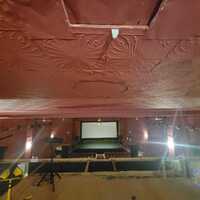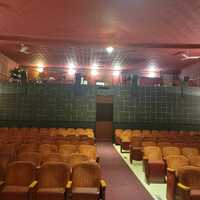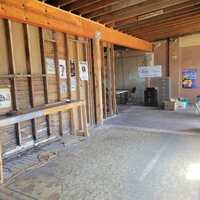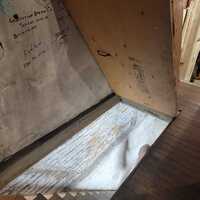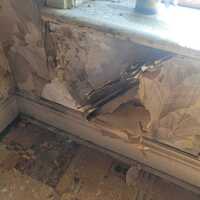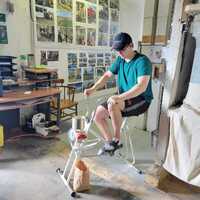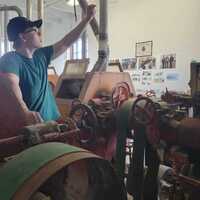Oct 16, 2025 This is the third in our 2025 Haunted Heritage blog series. See all the entries in the series here. When I first started my research into Saskatchewans heritage places and sites I expected them to feel unfamiliar. I was, after all, far from the landscape I grew up in. Yet, to my surprise, the much-anticipated strangeness felt more like a peculiar sense of calm. These spaces – old theatres, mills, convents, and homes – were haunted not only by local histories and memory, but somehow also fragments of my own past (or ghosts of a past life). They blurred the lines between the personal and the historical/archival, between the living and what lingers after. This experience recalls what Freud describes as the unheimlich - a word often translated as the “un-canny,” but which more literally means the “un-homely” - which offers a way to understand this strange tension. The unheimlich captures these unsettling moments when the familiar turns strange, when the comfort of home carries a quiet unfamiliarity beneath its surface. It is not simply about fear or displacement, but about the uncanny intimacy of recognition – about finding traces of oneself in what seems other (Fisher, 2016, p. 8). In this sense, the un-homely offered me a way to understand that feeling of calm within the dislocation; that belonging can emerge from the unfamiliar itself. Mark Fisher’s ideas of the weird and the eerie help make further sense of this tension. The weird, as he describes it, is the unsettling presence of that which does not belong, while the eerie as the uncanny absence or misplaced agency; “something present where there should be nothing, or nothing present where there should be something” (Fisher, 2016, p. 10). Both, like the unheimlich, serve as conditions of hauntings, where the past never fully disappears and the present is never fully quite what it seems. Looking at Saskatchewan's heritage sites through the lense of the weird, the eerie and the un-homely revealed a kind of belonging - belonging not rooted in the familiar but discovered through the quiet recognition of home within the unfamiliar. Through my encounters with heritage, I began to see this ghostly logic at play. What Fisher frames in theory, resonated in practice as I made my way through some of these sites. Scholars working in the field of memory studies, such as Zuzanna Dziuban, describe the space where time overlaps and returns involuntarily as places becoming “mediums of haunting memory” (Dziuban, n.d., p. 116). Haunting, she writes, often manifests through involuntary memory – the sudden moments when ghosts remind us of what is repressed or forgotten. These returns of the past do not ask for permission, they arrive unabashed, and in their arrival they reconfigure how we understand both, place and self in the present. The first time I felt this uncanny overlap was at the Grand Theatre in Indian Head. Entering the century old opera house I was struck by the quiet. The auditorium, once full of voices and people, was empty. The Grand Theatre in Indian Head opened in 1904 as an Opera house and later converted into a theatre has seen numerous artists and eras pass through it and is still operational today. At the time of its construction, it was the only opera house found on the prairies, and it would grow to become a hub for travelling artists, movies, screen productions and musicians (Grand Theatre, n.d., “Early years”). When we visited it was silent, waiting, anticipating the voices of people who have walked through its doors since 1904; waiting for it’s community. This was the eerie in Fisher’s sense: the absence of something that ought to be there. The theatre was waiting for it’s audience, its velvet seats leaning forward like attentive ghosts. The weird was there too. In the projection booth sat sleek studio lights, casting a glow on the theatre stage down below. Behind these is a living quarters that might have been built to house the owner (Arthur J. Osment) and his family, now it too waits with peeling wallpaper exposing decades of renovations. Waiting for re-animation. This juxtaposition was startling, an intrusion of the present in a building saturated with the past. In that moment, I felt less like a visitor and more like a figure folded into the fabric of the theatre itself. It was as if I existed twice over—my present self sitting in the quiet hall, and another self merged with the imagined crowds of a century ago. Fisher’s notions of the weird and the eerie ceased to be abstract ideas; they became palpable sensations: the glow from the lights that did not seem to belong, and the stillness of rows of expectant seats without an audience. The theatre’s very surfaces—the curling edges of wallpaper, the patched walls, the faded paint—seemed to exhale time, accumulated layer upon layer. For an instant, I stood in a threshold where history loomed close, and where memory asserted itself as presence rather than nostalgia A few weeks later, at the Yorkton Brick Flour Mill, I experienced a different kind of haunting. Constructed in 1898 the mill was the first of its kind to be built out of brick at the time when most flour mills were made from wood, but after a century of operations the mill fell into disrepair. It wasn't until the 2010‘s when efforts started to preserve the mill as an ode to the towns agricultural past and to convert it into a community hub (History, n.d., “Timeline of the Mill”). During our visit to the mill, a volunteer demonstrated the manual cranking of flour, the rhythm of metal grinding against the grain. As I watched, a memory surfaced with startling clarity: afternoons spent in my father’s plastic factory, oceans and continents away. The industries, let alone the landscapes, could not be more different – grain vs plastic, heritage mill vs industrial plant – yet the textures and sounds converged in my mind. The faint smell of dust, the repetition of manual labour under human effort: all of it transported me back to my childhood. Here, Fisher’s weird and eerie merged. The weird lay in the uncanny resemblance between two spaces that had no logical connection: a Saskatchewan flour mill and a Pakistani plastic factory. They overlapped in ways that should not make sense, and yet they did. The eerie emerged through the memory of my father in a place he had never been – the ghostly agency that filled the room without him. Dziuban’s insights into hauntings as involuntary memory captured this perfectly. The past was not something I chose to recall, rather it returned on its own, inserting itself into the present moment. This haunting, however, was not unwelcome. It offered a sense of comfort. The flour mill became familiar precisely because it awakened my own ghosts. In that foreign mill, thousands of miles away from what is familiar to me, I felt at home. These encounters taught me that heritage is not fixed to one origin, group or history. The Grand Theatre and the Yorkton Flour Mill did not belong only to the communities that built and housed them; they became relational, open and dynamic. Their weird and eerie qualities created portals through which my own memories and identity seeped through. Fisher suggests that the weird signals the intrusion of something from the outside, while the eerie raises questions of agency. In both cases, I found myself drawn into the story, not as an outsider, but as someone folded into its layers. Heritage, then, is not only about preservation and commemoration of the past – its is also about the ghostly intersections and entanglement of memory, time, and identity. These places work to unsettle history, to allow for fragments of memory – both personal and collective – to surface in ways that collapse time and distance. In moments when what should not belong, insists on being present, or when the absence of something takes on its own unsettling weight, – it is in those moments that memory arrives, uninvited, yet demanding. For me, this has meant finding belonging, not in familiarity, but in the strangeness. Maha Abbas is a research Intern at Heritage Saskatchewan. She has written for our blog before. Dziuban, Z. (n.d.). Memory as haunting. HAGAR Studies in Culture, Polity and Identities , 12, 111–135. Fisher, M. (2016). The weird and the eerie (Third edition). Repeater Books. History. (n.d.). Yorkton Brick Flour. Retrieved 5 October 2025, from https://www.yorktonflourmill.ca/history Https://www. Grandtheatre1904. Com/our-theatre. (n.d.). Retrieved 5 October 2025, from https://www.grandtheatre1904.com/our-theatre The ghost of memory

The weird and the eerie
Ghosts of the living
References

